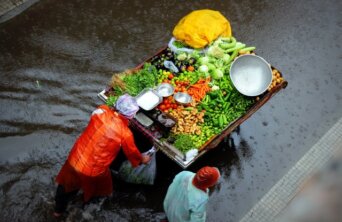- About
- Topics
- Story
- In-Depth
- Picks
- Opinion
- News
- Donate
- Signup for our newsletterOur Editors' Best Picks.Send
Read, Debate: Engage.
| topic: | Climate Change |
|---|---|
| located: | India |
| editor: | Bindu Gopal Rao |
Northern India has borne the brunt of heavy rains this July. With the Ravi, Beas, Sutlej, Yamuna, and Ganga rivers reaching record levels, the spate has caused, among other things, collapsed bridges, caved-in roads, landslides, flash floods, and a series of evacuations.
As flash floods plagued Ladakh, the River Yamuna reached the walls of the iconic Taj Mahal for the first time since 1978.
Over 100 people have died in floods in Himachal Pradesh, Uttarakhand, Haryana, Punjab, and Uttar Pradesh, causing house collapses and flash floods.
The Government has set up more than 2000 shelters in response to the destruction and issued alerts to stay at home, with several schools and colleges declaring holidays.
Flooding has become a common, visible reality of climate change in India.
The detrimental effects of flooding are felt mainly by the weaker economic sections of society, including marginalised groups and people experiencing poverty. Assam's North-Eastern state holds 15 of the 25 most vulnerable districts to climate change.
Damage caused to drainage systems by a major real estate development in Bengaluru has also led to flooding in the country's IT Capital and will cost a massive $339 million to fix, a report has found.
The burning question is how to prevent floods and their associated costs. The responsibility falls on the local civic bodies and municipal corporations who oversee infrastructure and ensure proper sewage and drainage systems. Additionally, the Government should prioritise the maintenance of bridges and roads.
One potential solution to addressing and minimising the impacts of flooding is through a holistic approach.
NGOs are chipping in; the International Centre for Integrated Mountain Development has worked on developing an early warning system that alerts people of potential floods via a sensor installed below the bridge that alerts users on their phones about rising water levels. It started in Nepal and is now used in Assam.
Likewise, The United Nations Environment Programme (UNEP) and its partners have been working to reduce the impact of flooding. Many NGOs are gathering funds and supplies to aid those impacted by floods, but the crucial challenge lies in devising strategies to prevent them from occurring in the future. After all, prevention is a cure, and this adage is most appropriate in this situation.
Image by Milind Ruparel.

